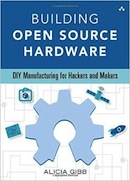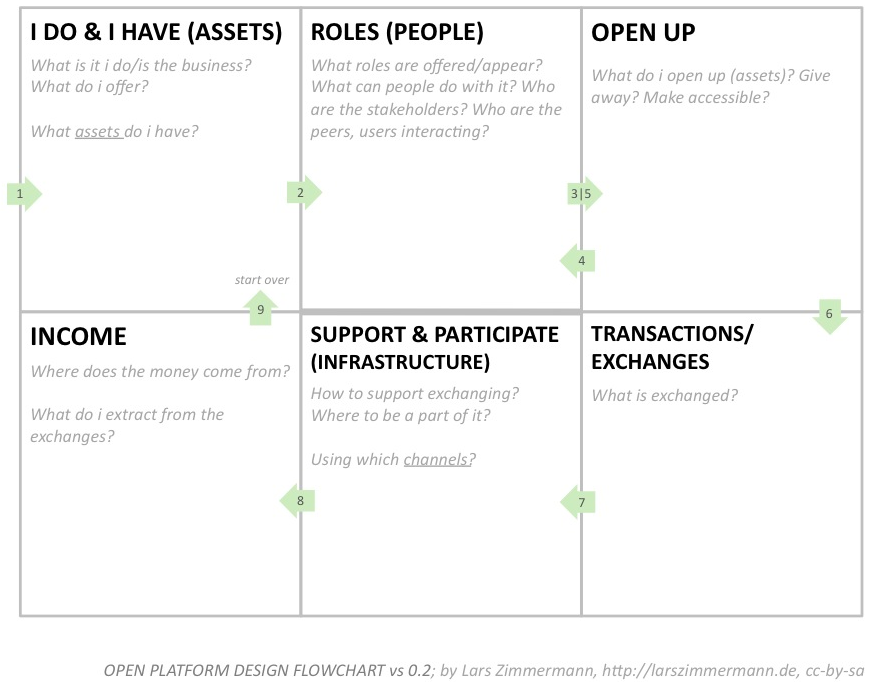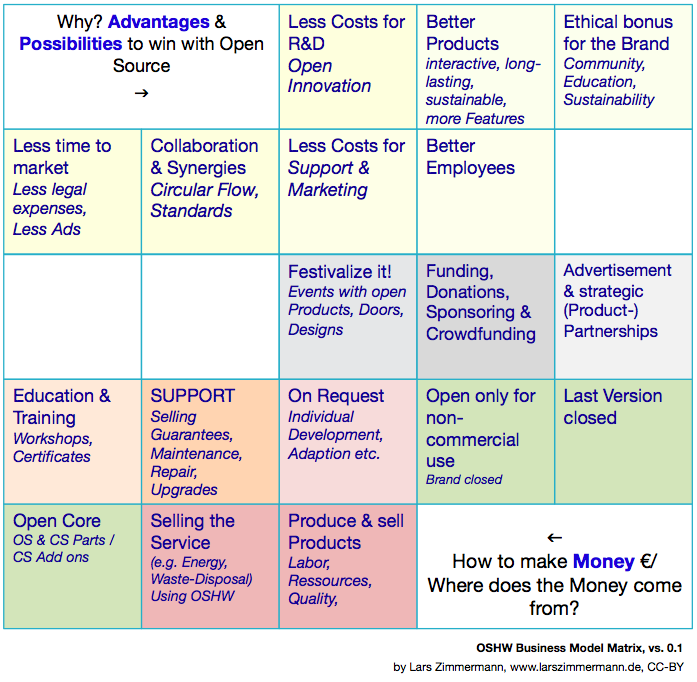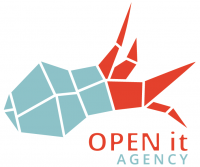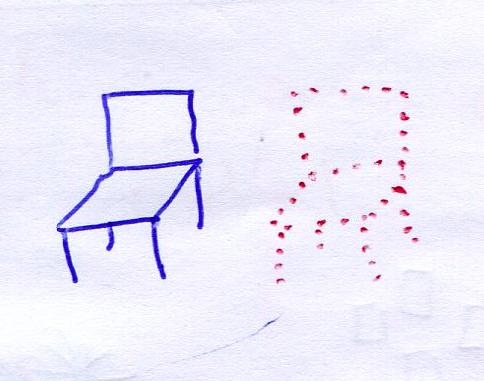Business Models for Open Source Hardware & Open Design
(2013* – ACTIVE)
I research and explore Business Models for Open Source Hardware since 2013. This work has gone through several iterations and has produced a number of resources. Start with the newest one!
5
Video Series & Tool: Open Source Business Models for Circular Economy“
I created a new tools and fully documented VIDEO series about it. You can find all videos and resources coming with it here.
I think with this tool and explanation my search for a good explanation on OSHW-Business Models ends for now. When I run a workshop with the Tool for the first time I see satisfied faces. This explanation works!
Video 1
Video 1 out of 9; find all videos here
Tool (Download behind the link)
(It is an updated version of the Platform Design Flowchart.)
4
Full Business Chapter of „Building Open Source Hardware“
I wrote the the business chapter for the book „Building Open Source Hardware“. Proofread english and extended information! The whole chapter is published and for download here in the blog.

The chapter presents and explains the updated version (0.5) of the OSHW-Business Model Matrix.
3
Open Platform Design Flowchart
Some products or projects are likely with opening up to become a platform. Diving into the product-like-a-platform approach opens up new perspectives and allows you to develope suiting strategies and a business model. The product-like-a-platform point of view occured to me very clear for the first time while reading some of the great articles of the italian open source strategist Simone Cicero.
In his article „why choose to be open source in the hardware industry“ Simone writes: „…creating an open source platform for hardware innovation can appear difficult on one hand (people tend to think “they will copy me” and tend to think it as a bad thing).“ Exactly. To get copied is not necessarily a bad thing: Just design your business or platform around this, make copying a productive part. Everybody who copies wordpress makes wordpress grow and is good for its business.
Simone developed a Platform Design Toolkit with the Platform Design Canvas in its center. Simones Canvas is a fork/derivative of the very successful Business Model Generation Canvas of Alex Osterwalder. Osterwalders Canvas is good for sketching out linear businesses, Simones fork aims to help with platform designing.
I really like this idea and i tried to work with the canvas but did not get very far. I think, one of the reasons for this was that i don’t know the original tool well enough and already have trouble with understanding some terms there. And with the transformation to a new tool the fuzziness increased for me. So i had to give up and started, inspired by Simones general idea, to develope a new, simpler and for me more suiting tool – the Open Platform Design Flowchart. You can find it below. Take a look and start working with it. But i encourage you to test Simones canvas also, maybe that one workes better for you.
The Chart
DOWNLOAD THE TOOL IN PDF, PPTX, JPEG
Above you find the tool and a presentation of it. I tested the tool surprisingly successfull in a workshop with 34 people from 22 countries at ecovillage 7Linden supported by Leslie and Rakesh (a blogpost about it here from Leslie). People said to us, that during the thinking-process the tool guides through, they had profound insights into openness and its possibilities and that they gained new fresh perspectives on their projects. I will develope the tool further and will be happy about your feedback.
How to use
For now i think (or hope), the tool is mostly self-explanatory but here is a small introduction:
The Chart is divided into 6 columns. In every column you fill in some information building upon the informations of the columns before. By going rounds through the chart you find and complete your story(ies) and platform strategies. The columns are:
1. I DO & I HAVE (ASSETS): What is it i do/is the business? What do i offer? What assets do i have?
Comment: List what you do and with what. Example: a cafe, a kitchen and some cooking skills.
2. ROLES (PEOPLE): What roles are offered/appear? What can people do with it? Who are the stakeholders? Who are the peers, users interacting?
Comment: Every business offers roles for other people. When you are building tables you are offering people the roles of customers/buyers of your table and others to be resellers of your table.
3. OPEN UP: What do i open up (what assets)? Give away? Make accessible?
Comment: This is the key part of the chart. What do you open up/make accessible? When you are selling tables you of course make tables accessible. But this column encourages you, to open up more of your assets for example the CAD-files for your table, which is one of your assets.
After you filled in something here you go back to column two. Because in most cases opening up new things goes along with new possible roles you offer to people. When you open up the building-plans of a table other developers and producers become a possible part also teachers, that might use the files in thier classes.
4. TRANSACTIONS / EXCHANGES: What is exchanged?
Comment: Identify what gets exchanged between you and the roles or between people in general concerning your platform. This asks for material things (like tables, money, building plans) and immaterial things (like values, abbilities/skills, attention).
5. SUPPORT & PARTICIPATE (INFRASTRUCTURE): How to support the exchanging? Where to be a part of it. Using wich channels?
Comment: Exchanging needs channels, an infrastructure where it can happen and gets supported. Skills get exchanged in workshops, tables on warehouses/markets etc. Look also up to the roles. What do they need? Make yourself aware of the channels. But focus here mostly on those channels, you like to provide or use yourself.
6. INCOME: Where does the money come from? What do you extract from the exchanges?
Look at the channels and transactions, where is your income? Providing channels very often gives possibilites for income, for extracting some of the exchanged things. Channels are often harder to duplicate than building plans for example. To find your answer here you can also use the bottom part the open source hardware business model matrix below. Be aware: your income is not necessarily limited to money.
After you are done with colum six you can start the whole process over. Is something missing in the first column now, maybe you want to add some of the channels as assets? Repeat as long as it takes till you have all your storylines clear. Hopefully you found a scenario in which your product is a platform and economically working..
2
Open Source Hardware Business Model Matrix
Matrix Vs 0.1
Download matrix vs 0.1 pptx (Libre Office, Open Office, PowerPoint), PDF
Explanation of the Matrix (0.1)
Slides for a (german) lecture explaining (some) the matrix
The matrix is devided in two parts. The upper part lists the possible advantages that could arise, when you go open source. Going open source gives you a lot interessting possibilities and chances to develope and organize your idea, business or project. Advantages you can not use, when you are closed. You could build your business model around these.
The part that starts at the bottom just lists income possibilities: where does the money come from?
Between everything you can figure out your individual business model. Which elements work for you, what is your individual combination?
There are empty spaces in the matrix because the field ist still developing and to leave an open space for your ideas and imagination.
You will find here at least some information on every square of the matrix. But its just entry points. There is of course a lot more to say and to find. The matrix is an organization model for knowledge you already have of find somewhere else.
*VIDEO; for german speakers: There is also a video, that explains some parts of the matrix. (Talk is about vs. 0.02)
.
2.1 Advantages and possibilities with Open Source
What to win with beeing open? What are people doing, when there are open?
Open Innovation
Open innovation is for most people a very promising chance you have with open source. Having your building plans open and also your problems gives many people the chance to look at it and help you with that. People can look at your designs and share their ideas, how to make it better. You can receive some great input, help or feedback. Open innovation has very often proven to be faster, cheaper for you and to produce solutions of a better quality. There is a lot literature about open innovation, also in the web.
Better products
Some products get better when they are open (and than sell better) because they are:
MORE INTERACTIVE
An open product provides maybe more possible ways to interact with it and use it or adapt it. Openness makes it easier to hack the product! Make your product a platform easy to play with and rearange for customers and third parties. Macgyverize the world! :-)
LONGLASTING
Openness makes it easier and cheaper to repair things. Also reuse of individual parts (maybe you have an modular design) is easier if the parts are open. The use of open standards makes it easier to adapt the product to new usecases.
Reduce > Repair > Reuse > Recycle
MORE SUSTAINABLE
There is a lot to say about openness and sustainability. Providing and producing a sustainable product is a lot easier in many cases if you chose to go open soure. Aspects of sustainability are in more than one square of the matrix. Here are some mentions: Ease of reapir, reuse and making a product longlasting as mentioned above. The chance to organize zero waste closed material cycles (100% recyling/regenerative design). Educational effects of openness. Open innovation as a driver for the spreading and discovery of sustainable products and production chains.
Sustainability is a valuable goal in itself. But for many business it also provides a lot of possibilities to do better business at all.
MORE FEATURES
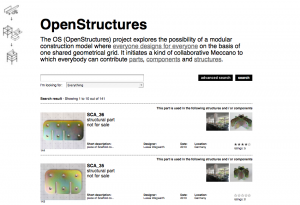
An open product has the build in possibility to work as a platform for other businesses. This could mean that those business live from developing and providing extra usecases for your product. This makes your product maybe easier to build and of course more valuable for the consumer. To understand this just look at the open structures project and imagine your furniture would have been build upon this grid. Take a look from time to time at this platform and find cool new ways how you could rearrange, transform it and take everything to a next level!
As for electronics: Think about the internet of things. Using and providing open standards makes it easier to connect everything to everything and gain yourself interessting network-effects out of networking your objects.
Ethical bonus for the brand
Open source is still a very young movement. But the chance that it will grow and become the next big thing are pretty high. Connected to success will come some common shared narratives and ideas about open source. Right now it is not 100% shure what this narratives will be. The narratives we have today ruling „open source is for free“ and „open source means do it yourself“ will clearly be outgrown. Whatever narratives will emerge it is realtively shure that they will have a very positive spin.
„I think open source could be the organic or fairtrade“ once the journalist Christoph Gurk said to me. And yes, almost all of the stuff you can say about open source is good and valued by people. Going open source means to connect all of this to your brand. But let us take a short look, what is there good to say about open source?
COMMUNITY
Open source focusses on the wellbeing of communities rather than the wellbeeing of individual people. Open source includes people in the design of their products and environment.
EDUCATION
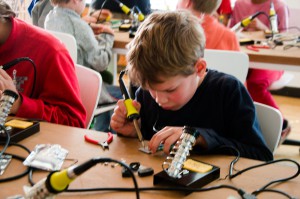
Open source treats and addresses people as intelligent, creative and responsible individuals. It shares knowledge and cares about educating and empowering people. Kids and adults can use all of their stuff as educational material. This is another thing than addressing them as just stupid consumers.
Educating people and motivate them to be a caring part of their environment is something high valued by our societies.
SUSTAINABILITY
Openness and sustainability are working greatly together as already described above. This fact is of course something you can make work for your brand.
FREEDOM
Lets get serious for a second. Open source gives you the „freedom to control your technology“. While closed things are more and more suspected to went behind your back and work secretly against you open source technology allows you to understand and control it more fundamentally. In a more and more complex and networked world this is a key feature to sustain your freedom and our democracy. Probably people will more and more understand this. And it will work for your brand as well as for your business.
Less time to market
There is of course more to say here as the matrix version 0.2 already does. But for starters:
LESS LEGAL EXPENSES
Closing things costs a lot of money. Patents, lawyers, law-suits, secrecy agreements, safety measures etc. are expensive. 2011 apple and google spend more money on legal issues than on research and development. Going open source could save you a lot of this money! Use it to make your product better!
LESS ADS
Chris Anderson makes this point in his book „Makers“: A viable community around your product is of course very interessted in its success and will be a part of promoting it. Good ressources can make great viral ads.
Collaboration & Synergies
If you have only time to say one thing about open source than you go probably with „open source is about collaboration“. Open source enables a lot of new and different ways to collaborate with others. Matrix vs. 0.2 points out two things in this square:
OPEN STANDARDS
Open standards makes it easier and maybe cheaper to develope your product, maintain it, connect it to others and provide good support.
A PRODUCT LIKE A PLATFORM

CIRCULAR FLOW/CLOSED MATERIAL CYCLES
Open Source is probably the key strategy towards closed material cycles. Making closed material cycles work for you could save you a lot of money for a variety of reasons. To learn more about the connection between open source and closed material cycles/regenerative design take a look at the OWi project.
Less Costs for Support and Marketing
Your product is only good as long as it is useful for the consumers. Very often support is needed. Support can be very expensive for you and hard to maintain. Opening up building plans allows others to do that work. People can share openly solutions for problems in the internet. Save money and have a better service and support infrastructure build around your product as you ever could have done it yourself.
Better Employees
Openness is very often used by compagnies to attract new and highly motivated and qualified employees. Open environments are very often more fun and more interessting to work in and easier to get interessted in from the outside. Take a look at this article about amazons problems to keep good employees with closed source methods.
* *
2.2 Money – How to make money with that?
Where does the money will come from?
Produce and sell products
The main answer is: „We sell products for more than it costs to produce them“. It is that easy. The knowledge is „free“ with open source. But the products arent’t of course. Physical products produced with care, skill, energy, time, ressources and equipement are still scarce. And what is scarce you can sell.
The building plans of this chair might be free, but when i use them to produce a chair for you you will pay me of course for my work.
Selling the service
When you are selling a service like energy, transportation, waste disposal you will always get paid for it. This wont change when you use open source hardware to produce the service: An open source power plant, an open source car, an open source waste disposal infrastructure will allow you to create your service with a better quality and maybe to a lower price because you can activate all the advantages of open source to run your infrastructure.
There will be one question asked in the future again and again: Why not public infrastructure like police cars, waste disposal, street lightning etc. all open source?
Open Core*
*- The next 3 models mix open source with closed source parts. This might not be 100% in the sense of the open source hardware definition which requires that you make everything commercial useable for everybody. But still here are some open parts. And for some businesses it might be interessting or make sense to work that way. And there is still something that is open. -*
Have an open core and sell exclusively addons or extra features. Freemium and Premium. The coffee machine is open but the pads needed for it are not. Your printer is open source but the cartridges are not etc. Still for the core you could use some of the advantages of openness.
Last Version Closed*
The new one is closed and sold exlusively to finance the development of the next one. All earlier versions are open. So people an study them and work with them and help you, to develope your next and better version. An example for that are the XYZ Spaceframes: There are manuals for different bikes but not for the cargo bike which you have to buy or to build in a paid workshop. Still, if you are smart, you can figure out the cargo bike from the other manuals.
Open only for non commercial use (dual licensing)*
If you have a patent you can publish your plans under two licenses. You allow everybody to rebuild your product and play with it as long as it is not for commercial reasons. Once someone wants to use your product commercially he has to contact you for an individual deal. This is really not an easy approach because „commercial use“ is really hard to define. Even if i have a party where i invite my friends and we build in our garage your product just for fun. When they give me some money as contribution for the beer i bought you can argue that i made commercial use of your product. But maybe for some products dual licensing makes sense although it limits the positive effects and possibilities of open source very much.
On Request
You build something only when someone requests it, maybe you build customized versions of it. SÖREN the irrigation System is open source. But still someone has to install it and adapt it to individual situations. Why not hire guys who invented or codeveloping everything? (This one is close to „Selling the Service“ above.)
Support
An open building plan still needs someone who guarantees for it to work. You sell the hardware and people buy it from you together with a contract that guarantees the hardware to work. You maintain it. Beeing open and a codeveloper of the hardware makes it easy to trust your skills and the service. You have interesst in codeveloping the hardware. (This is also in some parts closed to „Selling the Service“) This business model can very often be seen in open source software.
Education & Training
This is also something we know from the open source software world: Train the people who have to use or maintain the hardware, sell workshops and certificates. As inventor or main-developer of everything you have the authority to do so.
Another way to look at this is „Build or Buy“. People can buy the product from you or hire you for a workshop to learn how to build the product themselve.
Advertisement & „strategic Product-Partnership“
A good platform, good ressources attract attention. Maybe there are elegant ways to monetize this with ads. You produce tutorials? O.k. why not use Screws bought from the „Screwbadu-Compagny“ in it and mention, that you are using them. Product placement so to say. As long as you are allowed to say, that you could also use other screws … this could be ok. Partnerships like this can imagined in a million different ways.
Funding, Donations, Sponsoring and Crowdfunding
Funding from the state, sponsoring or donations might work for your product especially when we are talking about research.
The foundation-model that works for some open source software projects very well could also work for some hardware projects.
Crowdfunding could also be a way to gain some income. Some software projects are working right now with monthly campaigns. The literature about crowdfunding explodes currently. Just search the web. But it is still not really shure how good it can work as an income source. Especially in the log run.
Festivalize it!
Open things are easy and fun to celebrate. I was at a festival on open design and they had a temporary open design shop that made good business during the festival profiting from the attention.
*
ok. So much for this little overview and introduction. Stay tuned to this blog to receive updates also on the matrix or get in touch for more. You can book the Open It Agency for workshops on or lectures on the matrix or related topics.
3. More Sources
A small selection of great real great sources of others on the matter + a little list of other texts by me.
- Chris Anderson „Microeconomics for Makers: Business Models for the New Industrial Revolution“ (Video with Talk, 31:14min); [Download Mirror Mp4, 99mb]
- Full Business Chapter of the Book „Building Open Source Hardware“
- Slideshare by Benjamin Tinq: Business Models for Open Source Hardware
- Article by Mathilde Berhon (Making Society): 8 Ways to Make a Living with Open Source Hardware
- A Classic: Kevin Kelly – Better Than Free // Klassiker: Kevin Kelly – Besser als kostenlos
- A short, simple and still interessting read by Open Soure Hardware Labs (Marco Schwartz): 5 Ways to Make Money with Open-Source Hardware
- Very short and simple list with answers by Cesar Harada: How do you make money with Open Hardware?
- Why choose to be Open Source in the Hardware Industry – Simon Cicero (about electronics)
- DIY Recording Equipment Podcast #5: „Is Open Source the Way Forward for DIY Audio?“ by Peterson Goodwyn with Eric Jennings of Pinocc.io (Podcast with Interview, 18:31min); [Download Mirror Mp3, 9mb]
- Way to many ☺ but Michel Bauwens collects sources about the subject in the P2P Wiki for years now
Some more Texts by me
1
TEXT: Who Pays The Designer? Open Design Business Models (only german)
Find the full text (german) here.
